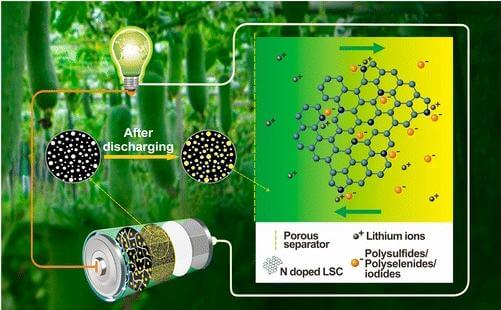From ACS Applied Materials & Interfaces

A carbon material derived from loofah sponges could be used in the next generation of lithium batteries.
Today’s mobile lifestyle depends on rechargeable lithium batteries. But to take these storage devices to the next level — to shore up the electric grid or for widespread use in vehicles, for example — they need a big boost in capacity. To get lithium batteries up to snuff for more ambitious applications, researchers report in the journal ACS Applied Materials & Interfaces a new solution that involves low-cost, renewable loofah sponges.
The lithium-ion batteries that power most of our devices still have some room for improvement. But some experts predict that even when these batteries are fully optimized, they still will not be able to meet the power needs for larger-scale applications, such as taking a car 500 miles on one charge. Scientists looking to go beyond lithium-ion have turned to lithium-sulfur and other options. But a major challenge to commercializing these technologies remains: The cathodes crumble over time, leading to progressively lower capacity. Shanqing Zhang, Yanglong Hou, Li-Min Liu and colleagues wanted to find a way to stabilize these alternatives.
The researchers developed a “blocking” layer of highly conductive, porous carbon derived from a loofah sponge. The loofah-derived membrane helped prevent the cathode from dissolving in lithium-sulfur, lithium-selenium and lithium-iodine batteries — and all three types performed well consistently over 500 to 5,000 cycles. The loofah sponge carbon could be the advance needed to move these batteries forward in a low-cost, sustainable way, the researchers say.
The authors acknowledge funding from the Australian Research Council, the National Natural Science Foundation of China and the Ministry of Education of China.
Filed Under: Energy storage, News




